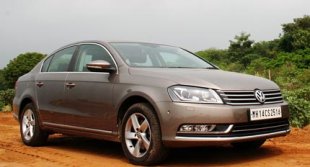
Now, in 2011 now there is a new Passat. It was launched at the Paris Motor Show in September 2010. While internally it is designated B7, the visible changes seem to be in the grille and headlights as well as the external body panels. Interestingly, the Passat and its derivatives have been rebadged and sold around the world under various names like Dasher, Santana,Quantum, Magotan,Corsar and Carat.
So how do you grab eyeballs and sell cars in a market that already has players like BMW, Mercedes, Audi, Volvo and Skoda, not to mention the Japs? For VW, it means first doing a Maruti and by that I mean targetting the family-oriented buyer, who is more interested in a fuel-efficient (kitna-deti-hai) car. Then you pack it with features, especially those that are not available in the segment (read Mercedes C 220CDI, the BMW 320D, the Audi A4, the Volvo S60 T6 and the Skoda Superb). Lastly, you make it affordable. The Passat is available with just one engine in India whereas in the West there is a range of engines, petrol and diesel, to choose from. However, it is the top of the line engine, a 2.0L Common Rail TDI unit developing 170BHP of power and 350Nm of torque from 1750-2500 rpm.
As I mentioned earlier, there is a host of features and innovations to talk about so I'll start with BlueMotion. This is not one feature but a host of features that work together to make the Passat both economical and Umwelt Freundlich (environment friendly). First of all, there is the Start-Stop System. It cuts emissions and saves fuel by automatically switching off the engine when waiting in traffic, and starts automatically as soon as the driver steps on the accelerator. Emissions are also reduced by treating the exhaust gases for NOx. Then there is the Brake Energy Recuperation system. Every time you brake while driving at speed, the energy which is lost usually via heat dissipation is recovered and used to charge the battery which VW say lengthens battery life. Then there is the DSG gearbox which is very akin to the Wilson pre-selector gearboxes from vintage times, where one selected the next gear before getting into it. The DSG box is an automatic of course but functions in a somewhat similar fashion to ensure there are no hiccups during acceleration.
No comments:
Post a Comment